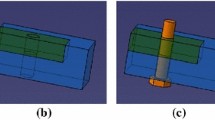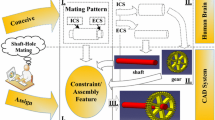Abstract
In mechanical product design, rapid and effective simulation is invariably essential since the design flaws can be spotted by the simulation results in advance. However, currently, most designers always perform assembly process and kinematics simulation separately, which may lead to repetitive work and low design efficiency. To address the problem, this paper presents a novel method for product design which aims to integrate the assembly process and kinematics simulation seamlessly. To begin with, a semantic modeling method for part information is introduced, which is the premise and foundation to achieve the integration. Secondly, the assembly process simulation is carried out according to the defined steps derived from interactive semantic reasoning among parts. Moreover, the completed assembled model is utilized to generate kinematic pairs automatically, which can help avoid a lot of unnecessary preparations for kinematics simulation. Meanwhile, physics engine is adopted to provide a stable kinematics operation. Based on these, the assembly plan and motion characteristics of a new product can be analyzed effectively and quickly. Therefore, the designers can obtain the analytical results and attempt different design schemes readily. Finally, the effectiveness of the integrated simulation method is verified by a case study of excavator assembly process and kinematics simulation.
Similar content being viewed by others
References
Marsh R, Jonik M, Lanham J, Cheung WM, Newnes LB, Mileham AR (2010) Modelling an assembly process using a close coupled generative cost model and a discrete event simulation. Int J Comput Integ M 23(3):257–269
Cao W, Shao XD, Liu HL (2016) Enhancing fidelity of virtual assembly by considering human factors. Int J Adv Manuf Technol 83(5-8):873–886
Robert I, Diana P, Frederic N, Cedric M (2017) Implementation and evaluation of a model processing pipeline for assembly simulation. Assem Autom 37(4):400–410
Parag V, Oliver M, Jafar J (2014) Dimensional management for aerospace assemblies: framework implementation with case-based scenarios for simulation and measurement of in-process assembly variations. Int J Adv Manuf Technol 70(1-4):215– 225
Yang RD, Fan XM, Wu DL, Yan JQ (2007) Virtual assembly technologies based on constraint and dof analysis. Robot Comput Integr Manuf 23(4):447–456
Zhu HM, Wu DL, Fan XM (2010) Interactive assembly tool planning based on assembly semantics in virtual environment. Int J Adv Manuf Technol 51(5-8):739–755
Shin JH, Jun HB, Kiritsis D, Xirouchakis P (2011) A decision support method for product conceptual design considering product lifecycle factors and resource constraints. Int J Adv Manuf Technol 52(9-12):865–886
Kevin CT, Waleed E (2012) An intelligent system based on concurrent engineering for innovative product design at the conceptual design stage. Int J Adv Manuf Technol 63(5-8):421–447
Vila C, Albinana JC (2016) An approach to conceptual and embodiment design within a new product development lifecycle framework. Int J Prod Res 54(10):1–19
Shi B, Jin Y (2008) Analysis and evaluation for assembly behaviour of reheat stop valve based on virtual prototyping. Eng Comput 25(7):637–656
Huang W, Kong Z (2008) Simulation and integration of geometric and rigid body kinematics errors for assembly variation analysis. J Manuf Syst 27(1):36–44
Junior SM, Moscheto A, Cziulik C, Sulevis M (2017) Space claim analysis for addressing maintenance of key components in complex products. Assem Autom 37(1):71–83
Jayaram S, Jayaram U, Wang Y, Tirumali H, Lyons K, Hart P (1999) VADE: a virtual assembly design environment. IEEE Comput Graph Appl 19(6):44–50
Gao W, Shao X, Liu H (2014) Virtual assembly planning and assembly-oriented quantitative evaluation of product assemblability. Int J Adv Manuf Technol 71(1-4):483–496
Tan JR, Liu ZY, Zhang SY (2002) Intelligent assembly modeling based on semantics knowledge in virtual environment. Proceedings of the International Conference on Computer Supported Cooperative Work in Design, London, pp 568–571
Seth A, Vance JM, Oliver JH (2011) Virtual reality for assembly methods prototyping:a review. Virtual Reality 15(1):5–20
Ma W, Zhong Y, Tso SK, Zhou T (2004) A hierarchically structured and constraint-based data model for intuitive and precise solid modeling in a virtual reality environment. Comput Aided Des 36(10):903–928
Zhong Y, Ma W, Shirinzadeh B (2005) A methodology for solid modelling in a virtual reality environment. Robot Comput Integr Manuf 21(6):528–549
Wan H, Gao S, Peng Q, Dai G, Zhang F (2004) MIVAS: a multi-modal immersive virtual assembly system. ASME 2004 International Design Engineering Technical Conferences and Computers and Information in Engineering Conference, Salt Lake City, pp 113–122
Berta J (1999) Integrating VR and CAD. IEEE Comput Graph Appl 19(5):14–19
Liu ZY, Tan JR (2007) Constrained behavior manipulation for interactive assembly in a virtual environment. Int J Adv Manuf Technol 32(7-8):797–810
Wang Y, Liu JH (2013) Subassembly identification for assembly sequence planning. Int J Adv Manuf Technol 68(1-4):781–793
Qiu SG, Fan XM, Wu DL, He QC, Zhou DJ (2013) Virtual human modeling for interactive assembly and disassembly operation in virtual reality environment. Int J Adv Manuf Technol 69(9-12):2355–2372
Marcelino L, Murray N, Fernando T (2003) A constraint manager to support virtual maintainability. Comput Graph 27(1):19–26
Gonzalezbadillo G, Medellincastillo H, Lim T et al. (2014) The development of a physics and constraint-based haptic virtual assembly system. Assem Autom 34(1):41–55
Wang P, Li Y, Yu L, Zhang J, Xu Z (2016) A novel assembly simulation method based on semantics and geometric constraint. Assem Autom 36(1):34–50
Yue C, Su HJ, Ge QJ (2012) A hybrid computer-aided linkage design system for tracing open and closed planar curves. Comput Aided Des 44(11):1141–1150
Alvarez JC, Su HJ (2012) Vrmds: an intuitive virtual environment for supporting the conceptual design of mechanisms. Virtual Reality 16(1):57–68
Zhang ZX, Liu JH, Ning RX (2010) Kinematics analysis of mechanisms based on virtual assembly. Chin J Mech Eng-En 23(6):748–757
Rajan VN, Lyons KW, Sreerangam R (1997) Assembly representations for capturing mating constraints and component kinematics. IEEE International Symposium on Assembly and Task Planning, Marina del Rey, pp 206–211
Xu WL, Zhang SY, Yi GD, Fu Y (2008) Motion constraint recognition and its application oriented to multibody simulation (in chinese). Chin J Mech Eng 44(6):137–142
Wang CE (2001) The technology on grid partition and visual display for scientific computing. Science Press, Beijing
Chen L, Qin G (2010) Optimization of the collision detection technology in 3D skeleton animation. IEEE International Conference on Computer Application and System Modeling, Taiyuan, pp 539–543
Real-time physics simulation. www.bulletphysics.org. Accessed on 2 May 2015
Open CASCADE Inc (2007) Open CASCADE 3D modeling kernel. www.opencascade.com. Accessed 13 Mar 2015
Zhu WM, Fan XM, Wu ZH (2017) Adaptive Grasping and Adjusting Method of Virtual Hand Gestures with Semantics Information for Virtual Assembly. Proceedings of the 23rd International Conference on Industrial Engineering and Engineering Management, Wuhan, pp 57–62
Orlandea N (2004) Design of parallel kinematic systems using the planar enveloping algorithm and adams computer program. P I Mech Eng K-J Mul 218(4):211–221
Wang X, Wang X, Zhang Z, Zhao Y (2016) Motion Planning of Kinematically Redundant 12-tetrahedral Rolling Robot. Int J Adv Robot Syst 13(1):1–10
Qic C, Tao J, Li L, Liu C (2017) An Adams-Moulton-based method for stability prediction of milling processes. Int J Adv Manuf Technol 89(9-12):3049–3058
Wang AH, Bahattin K, Rakesh N (2005) Complex assembly variant design in agile manufacturing. Part II: assembly variant design methodology. IIE Trans 37(1):17–33
Yu GD, Yang Y, Liu AJ (2015) Joint optimization of complex product variant design responding to customer requirement changes. J Intell Fuzzy Syst 30(1):397–408
Funding
The work is supported by the National Natural Science Foundation of China (No. 51475291).
Author information
Authors and Affiliations
Corresponding author
Rights and permissions
About this article
Cite this article
Zhu, W., Fan, X., Tian, L. et al. An integrated simulation method for product design based on part semantic model. Int J Adv Manuf Technol 96, 3821–3841 (2018). https://doi.org/10.1007/s00170-018-1808-1
Received:
Accepted:
Published:
Issue Date:
DOI: https://doi.org/10.1007/s00170-018-1808-1




